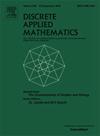局部最小防御联盟的参数化复杂性
IF 1
3区 数学
Q3 MATHEMATICS, APPLIED
引用次数: 0
摘要
一个图的顶点集合S是一个防御联盟,如果对于S中的每个元素,它的大多数邻居在S中。我们考虑了局部极小性的概念。我们感兴趣的是局部最小规模最大规模的防御联盟。众所周知,这个问题是np困难的,但其参数化的复杂性直到现在仍然是开放的。我们从参数化复杂性的角度加强了对问题的理解。本文的主要研究结果如下:(1)局部最小防御联盟即使在平面图上也是np完全的;(2)用解大小参数化的精确连接局部最小防御联盟的随机化FPT算法;(3)用邻域多样性参数化的局部最小防御联盟是固定参数可处理的(FPT);(4)用树宽参数化的局部最小防御联盟是W[1]-hard,因此不是FPT(除非FPT=W[1])。(5)对于树宽有界的图,局部最小防御联盟可以在多项式时间内求解。本文章由计算机程序翻译,如有差异,请以英文原文为准。
Parameterized complexity of locally minimal defensive alliances
A set of vertices of a graph is a defensive alliance if, for each element of , the majority of its neighbours is in . We consider the notion of local minimality in this paper. We are interested in locally minimal defensive alliance of maximum size. This problem is known to be NP-hard but its parameterized complexity remains open until now. We enhance our understanding of the problem from the viewpoint of parameterized complexity. The main results of the paper are the following: (1) Locally Minimal Defensive Alliance is NP-complete, even when restricted to planar graphs, (2) a randomized FPT algorithm for Exact Connected Locally Minimal Defensive Alliance parameterized by solution size, (3) Locally Minimal Defensive Alliance is fixed-parameter tractable (FPT) when parameterized by neighbourhood diversity, (4) Locally Minimal Defensive Alliance parameterized by treewidth is W[1]-hard and thus not FPT (unless ), (5) Locally Minimal Defensive Alliance can be solved in polynomial time for graphs of bounded treewidth.
求助全文
通过发布文献求助,成功后即可免费获取论文全文。
去求助
来源期刊

Discrete Applied Mathematics
数学-应用数学
CiteScore
2.30
自引率
9.10%
发文量
422
审稿时长
4.5 months
期刊介绍:
The aim of Discrete Applied Mathematics is to bring together research papers in different areas of algorithmic and applicable discrete mathematics as well as applications of combinatorial mathematics to informatics and various areas of science and technology. Contributions presented to the journal can be research papers, short notes, surveys, and possibly research problems. The "Communications" section will be devoted to the fastest possible publication of recent research results that are checked and recommended for publication by a member of the Editorial Board. The journal will also publish a limited number of book announcements as well as proceedings of conferences. These proceedings will be fully refereed and adhere to the normal standards of the journal.
Potential authors are advised to view the journal and the open calls-for-papers of special issues before submitting their manuscripts. Only high-quality, original work that is within the scope of the journal or the targeted special issue will be considered.
 求助内容:
求助内容: 应助结果提醒方式:
应助结果提醒方式:


